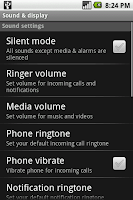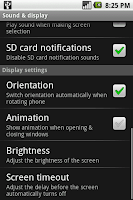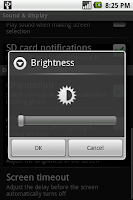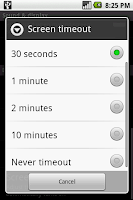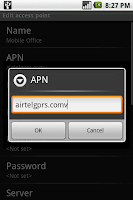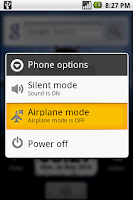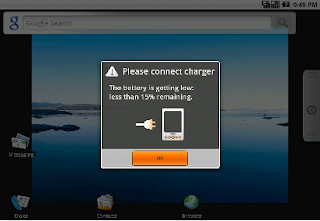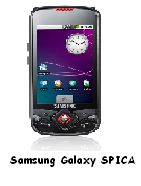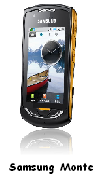 UPDATE(1 October 2010):: The latest revision of Budget android phones can be found here.
UPDATE(1 October 2010):: The latest revision of Budget android phones can be found here.It’s been nearly 3 weeks since the blog was started and the response is pretty impressive (you can check all the stats
here). Thanks to all the readers for visiting this blog and do visit in future also to get to know more about gadgets reviews and tips & tricks. I extend a warm greeting to all of you to come out with reviews of your gadgets, which sure will be helpful to all the other readers.
And now I would like to introduce a new section in this blog called leads which basically wont cover any reviews but will lead you to various options available in the market to whatever gadget you are looking for. To start with I decided to go with android phones also called as Droids as the heat of android is there all over this blog (the poll results speaks for itself).
When the android OS was released, leading manufacturers came out with devices with impressive specifications which meant it will be costly and buying them would be a dream altogether. Capacitive screen, camera, 3G,Wifi, GPS receiver and android packed together into a gadget will set you back to 30k and plus. And many times it-raised questions like Android is Open Source and still the device cost wasn’t affordable to many. And this year saw the release of handful of devices aimed at the lower segment with more such devices coming up at the end of 2010.
Before you zero on to a droid there are few things
you must consider. As posted in the “Android OS V 1.5 Cup Cake review”, one top priority of Android is to create an upgradeable system. This means you buy the hardware in the form of a phone with an OS with which you will get lifetime updates. So you enjoy new features every time a new version of Android comes out which is absolutely free. For this to happen you should buy a phone that can handle the future updates of the OS like say for example good memory and processing ability. And most importantly a manufacturer who is willing to give updates to the device.
So in this post I will cover some of the Android devices available in India in Rs 12,000 to Rs 16,000 range.
1)HTC Wildfire:

HTC is a Taiwanese company, which is very well known for its smart phones. This firm developed the first google phone called the G1 to the new google phone called the Nexus One. HTC have announced the new phone: Wildfire aiming the mass market. This phones build is pretty similar to the Google Nexus One and the HTC Desire phone. Here are the specifications:
·Operating system: Android 2.1 + HTC Sense User Interface
·Networks: GSM 850/900/1800/1900 MHz, EDGE/GPRS, UMTS/HSDPA 900/2100
·Processor: Qualcomm MSM7225-1, 528 МHz processor
·Internal: 512 MB + microSD (hot swappable)
·Interfaces: Wi-Fi, Bluetooth 2.1+EDR (A2DP), microUSB (USB 2.0) for charging and sync, 3.5 mm headphones jack
·Screen: TFT LCD - capacitive , 3.2” 240x320 pixels resolution (QVGA)
·Camera: 5 MPx with Auto Focus and Flash
·Other features: GPS , A-GPS, proximity sensor, light sensor, gyroscope, digital compass
·Battery: removable Li-Ion 1300 mAh
Now that is an impressive spec sheet for the lower segment completely satisfying the requirements I mentioned. The only drawback to this phone I see is the display resolution which is just QVGA (refer this post to know more about resolutions). But the impressive HTC sense user interface just makes up for that set back. This phone is announced and is expected to hit Indian market at the end of June. The estimated price of this phone in Indian Rupees is around Rs 16,000(announced for a price of 250 euros).
2) HTC Tattoo:

Another entry from HTC in this segment is HTC Tattoo. As the name indicates this phone is tattooed according to the buyers wish against available options. This phone too comes equipped with the impressive HTC Sense UI, which basically is GUI customization over the androids UI. Here is the spec sheet.
·Operating system: Android v1.6 (upgradeable to v2.1)+ HTC Sense User Interface
·Networks: GSM 850 / 900 / 1800 / 1900, EDGE/GPRS, HSDPA 900 / 2100
·Processor: Qualcomm MSM 7225 528 MHz processor
·Internal: 512 MB + microSD (hot swappable)
·Interfaces: Wi-Fi, Bluetooth 2.1+EDR (A2DP), microUSB (USB 2.0) for charging and sync, 3.5 mm headphones jack
·Screen: TFT LCD - resistive , 2.8” 240 x 320 pixels resolution (QVGA) with 65k colors.
·Camera: 3.15 MPx.
·Other features: GPS , A-GPS, proximity sensor, digital compass.
·Battery: removable Li-Ion 1100 mAh
This phone has a small display of 2.8 “ with just QVGA resolution and a camera with no auto focus and flash. It basically comes with v1.6 but can be updated to v2.1. And another let down is that the screen only supports 65k colors. This phone sells for around Rs 13,000.
3) LG GW620:

The GW620 is the first android offering from LG and is the only phone that comes with a physical slide out keyboard for the lower segment. Lets see what we have in this phone:
·Operating system: Android v1.6
·Networks: GSM 850 / 900 / 1800 / 1900, EDGE/GPRS, HSDPA 900 / 2100
·Internal Memory: 150 MB + microSD
·Interfaces: Wi-Fi, Bluetooth 2.0 +EDR (A2DP), microUSB (USB 2.0), 3.5 mm headphones jack
·Screen: TFT LCD - resistive , 3.0” 240 x 320 pixels resolution (QVGA) with 256k colors(65k active).
·Camera: 5 MPx, autofocus, LED flash.
·Other features: GPS , A-GPS, Accelerometer, digital compass,slideout keyboard,DivX Player.
·Battery: removable Li-Ion 1500 mAh
This is the only phone in the lower segment touch screen phone running Android, which has a slideout physical keyboard. This phone is also a DivX certified phone, which means you can play the conventional .avi media files. So far LG have not announced any updates for GW620. The display supports 256k but can display only 65k(as Android v1.6 supports only 65k). The phone costs around Rs 14,000.
4) Samsung Galaxy i7500:

Samsung galaxy is the phone that comes equipped with the brilliant AMOLED screen (check this post to know about AMOLED). Here are the specifications of Galaxy:
·Operating system: Android v1.5
·Networks: GSM 850 / 900 / 1800 / 1900 MHz, EDGE/GPRS, HSDPA 900/1700 /2100
·Processor: Qualcomm MSM7200A 528 MHz processor
·Internal memory: 8 GB + microSD (hot swappable)
·Interfaces: Wi-Fi, Bluetooth 2.0+EDR (A2DP), microUSB (USB 2.0), 3.5 mm headphones jack
·Screen: AMOLED - capacitive, 3.2” 320 x 480 pixels resolution (HVGA), 16M colors (65K effective)
·Camera: 5 MPx with Auto Focus and LED Flash
·Other features: GPS, A-GPS.
·Battery: removable Li-Ion 1500 mAh
Now this phones spec sheet is very impressive with the brilliant AMOLED screen, 5MPx auto focus camera with LED flash. But all these features gel well only with Android v2.1+, take for example the brilliant AMOLED capable of 16M colors but can deliver only 65k with v1.5. Unfortunately Samsung have not announced an update for this device and not sure if there will be an update in future. If there is an update then this phone will be a killer buy for its hardware spec sheet. The phone costs around Rs 15,000.
5)Samsung Galaxy Spica i5700:

There’s another offering from Samsung called the Galaxy SPICA which is the striped down version of the Galaxy. Here is the spec sheet:
·Operating system: Android v1.5 upgradeable to v2.1
·Networks: GSM 850 / 900 / 1800 / 1900 MHz, EDGE/GPRS, HSDPA 900/2100
·Processor: Samsung 800MHz processor
·Internal memory: 180 MB + microSD (hot swappable)
·Interfaces: Wi-Fi, Bluetooth 2.1+EDR (A2DP), microUSB (USB 2.0), 3.5 mm headphones jack
·Screen: TFT LCD - capacitive, 3.2” 320 x 480 pixels resolution (HVGA), 16M colors (65K effective)
·Camera: 3.15 MPx with Auto Focus.
·Other features: GPS, A-GPS, Accelerometer, Digital Compass, DivX player.
·Battery: removable Li-Ion 1500 mAh
As the above specifications say it’s a big let down on the imaging front with no flash. And like Galaxy, SPICA has a 16M screen but only 65k is effective as it runs Android v1.5. But Samsung has announced an update to v2.1 and also comes pre installed with V2.1 with recent packages. This is also a DivX certified phone. The phone sells for around Rs 12,500.You can read the review of this phone in this post.
Leads:
The Samsung Galaxy and Galaxy SPICA where introduced during November 2009 and were priced more than Rs 20,000. At the same time HTC introduced the Tattoo for around Rs 16,000. That was the time when Samsung made their pricing policy aggressive and decided to bring down the cost of SPICA to Rs 12,500 and Galaxy to Rs 15,000.And then LG wanted to catch up this low budget game with their slide out mobile GW620 making the competition even more tight. This battle has brought more options for the lower segment and made touch screen phones running Android a viable option.
Now we have seen 5 affordable devices to choose from, ranging from a device having a slideout keyboard to a DivX certified phone. On paper the yet to be released HTC WildFire and SPICA look interesting and are the only phones to come with the now stable Android v2.1 loaded with lots of features. These are different options to look for but we do not know how these devices perform in reality though we have reviewed SPICA recently, which is pretty impressive. The SPICA with an impressive hardware spec is a killer buy for its price. Check out the review and judge for yourself.
And for those who can wait a little longer here is good news though unconfirmed. Samsung is coming up with two more low end phones namely Samsung i5801 termed Galaxy 3 which is the successor of SPICA having AMOLED Capacitive screen and Samsung i5500 which is rumored to be a Corby series phone running Android. Both these phones have Android v2.1 running.
So if you are looking for an Android v2.1 rich in Features then the leads here is to HTC Wildfire,HTC Tattoo or Samssung Galaxy SPICA.
To know more on the above devices visit GSMArena.com for comprehensive reviews.
UPDATE(1 October 2010):: The latest revision of Budget android phones can be found here.

